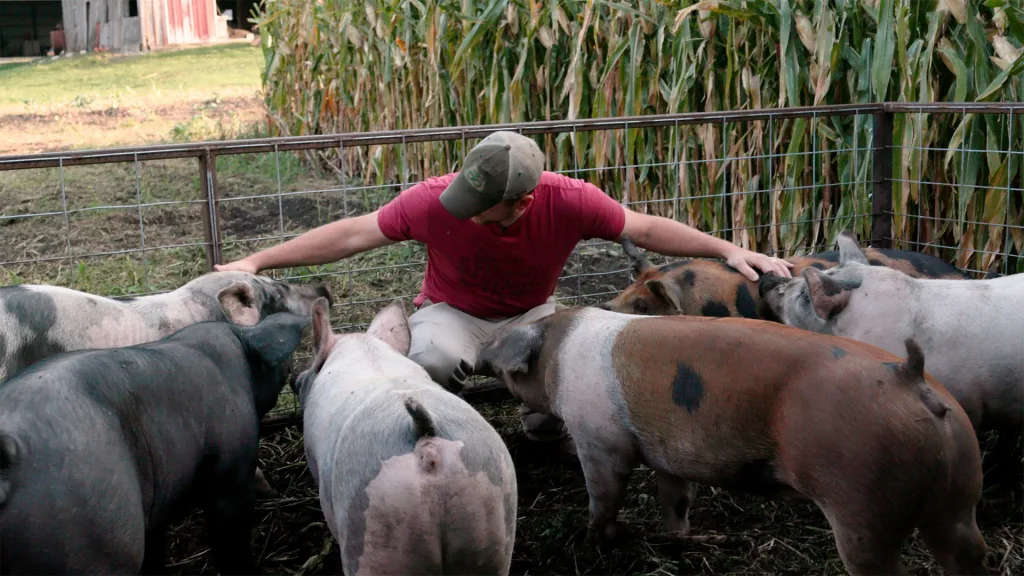New documentary shines a light on ultra-processed foods
New documentary shines a light on ultra-processed foods
Filmmakers Robert Kenner and Melissa Robledo are back with ‘Food, Inc. 2,’ which argues that additives from Big Food are manipulating our brains.
Many of the food industry’s problems can perhaps be summed up by the humble buttered-popcorn jelly bean. Love or hate this sweet treat, its 1989 introduction was a chewy harbinger of food scientists’ ability to make any food taste like any other food. If a sugary candy could send savory signals to the brain, what else was possible?
A lot, it turns out. Flavor technology has evolved rapidly in recent years. Forget about candy that smacks of toasty popcorn; lab-grown meat is now practically indistinguishable from the real thing. But as much as advances in bioengineering have leveled up the veggie burger beyond belief, among myriad other breakthroughs, they’ve also let loose a deluge of so-called health foods that might not be so healthy in the long run. The new documentary Food, Inc. 2, which is now playing in select theaters and available for rent on streaming platforms, argues that when a product’s calorie or fat count appears too good to be true, your brain and body may suffer from the deception.
Food, Inc., which came out in 2008, used corporate farming as a launchpad for exploring all manner of unethical practices in the modern food industry. Although some in the industry argued that the film offered only a one-sided interpretation, the Oscar-nominated documentary resonated so deeply with audiences, it nearly derailed filmmakers Robert Kenner and Melissa Robledo’s careers. Rather than move on to another project right away, the pair found themselves occupying dais-side seats on a never-ending rotation of food panels.
“There was a total explosion of interest that caught us by surprise, frankly,” says Kenner.
That explosion was accompanied by massive shifts in the culinary landscape. In the years after the film came out, the then-burgeoning Food Movement galvanized interest in environmental, nutritional, and labor concerns; the number of farmers markets spiked; and so did healthy alternatives in grocery stores. Also happening soon after: Wide adoption of the phrase “ultra-processed foods,” even as these foods continued to proliferate on store shelves.
Although Food, Inc. 2, like its predecessor, takes a shotgun-spray approach to covering several troubling topics, it spends a significant chunk of its runtime on ultra-processed foods—and how the additives within them are rewiring consumers’ metabolisms.
According to the U.S. Department of Agriculture, regular processed foods are those in which the nature of an agricultural product has been adjusted, either through heating, freezing, juicing—or many other alterations that are not inherently unhealthy. Meanwhile, ultra-processed foods, which have been getting a lot of bad press lately, are those that are so thoroughly divorced from the real foods that go into them, and riddled with unpronounceable additives, consumers might never guess what those foods were. A more succinct way to explain the distinction, though, as relayed in Food, Inc. 2, is that corn on the cob is unprocessed, canned corn is processed, and corn chips are ultra-processed.
On their own, the occasional hot dog, French fry, or Cheeto shouldn’t be too concerning for health-conscious eaters. However, Americans on average, consume ultra-processed foods for 58% of their total energy intake, compared to 17% in Italy. That’s a lot of chips and Oreos! The problem, though, stretches far beyond the many ultra-processed foods that are straightforwardly not healthy, the filmmakers argue. Where things get truly murky is in the ultra-processed foods that use additives to trick your brain into believing it’s tasting something it isn’t—and messing with its natural ability to sense nutrients.

“This was never a problem, historically,” says Mark Schatzker, a food journalist who worked on Food, Inc. 2. “Two hundred years ago, if something tasted sweet, it had sugar, and this was a reliable indication of simple carbohydrate calories. But now, there’s just an arsenal of additives—artificial and so-called natural flavors, fat replacers, and non-nutritive sweeteners—and this isn’t what the brain was designed for. It’s food that tells a lie.”
Schatzker’s main area of interest lies in the sensory aspects of food, which he unpacks in his books, The Dorito Effect and The End of Craving. Kenner and Robledo met the author while researching their film and ended up relying on him—both behind the scenes and onscreen—to help translate some of Food, Inc. 2’s more dense scientific concepts in a manner that is, well, more digestible. His work came to their attention through Yale professor Dana Small, whose experiment on fake sugar, which appears in the film, offers a crystal-clear distillation of how the brain and the body interact with food.
Small has a history of studying how the brain processes food reward. In 2001, she conducted what she believes is the first neuroimaging study of feeding in humans, monitoring the response to chocolate in areas of the brain that represent pleasure of eating. In the documentary, she claims Pepsi was interested in this research, and approached her many years later about finding a way to decrease calories in a sugar-sweetened beverage, without compromising reward. Small fed her volunteers a series of equally sweet beverages with different caloric content, and observed how their brains expressed food reward.
Her team expected that the most caloric beverage—the one with a 75-calorie taste and 150 delivered calories—would be the consensus favorite. That honor, however, fell to the middle-sweet, middle-calorie beverage—the one with a 75-calorie taste and 75 delivered calories. Through follow-up studies, Small discovered that when sweetness matched calories, the subject’s body metabolized that energy; but when something was too sweet for the amount of actual calories present—or not sweet enough—the mismatch ended up blunting their body’s natural metabolic ability. In the latter case, those calories weren’t being turned into fuel, but instead potentially accruing into fat.
Other scientists have conducted experiments with rodents to show that fat replacers have a similar effect, disrupting signals that could help control the rats’ food intake, and causing them to gain weight as a result. Too few studies in this realm have involved humans, though; something Schatzker attributes to the fat-replacer industry keeping a lower profile than that of artificial sweeteners, which have public-facing brands like Equal and Splenda. He believes more human studies need to happen around other additives, so people understand the full scope of health risks from ultra-processed foods.
Throughout their film, directors Kenner and Robledo weave the thread of ultra-processed foods in a broader tapestry of corporate responsibility. They depict how factory farms are overproducing, driving down the cost of raw materials, while processing those materials into unrecognizable culinary concoctions that drive up profits for the companies selling them. But while the film presents evidence that suggests ultra-processed foods drive consumers to eat them in excess, it also portrays corporations as reluctant to improve those foods’ nutritional value.
For instance, in the documentary, Small claims that when confronted with evidence that reducing calories with artificial sweeteners might be doing more harm than good, Pepsi questioned the data, claiming it didn’t make sense. Not long after, she alleges, the company pulled its funding. (Pepsi declined to comment on the claims in the documentary.)

The directors make the case that companies seldom voluntarily correct an unhealthy aspect of their product if the solution might interfere with profits. More commonly, they require a looming financial disincentive, as when Nestlé shareholders recently put some pressure on the company to prioritize healthier foods.
“I think what ends up happening is that the companies point to what consumers are buying—and they’re buying what they’re selling,” Robledo says. “It’s a self-reinforcing cycle, unfortunately.”
Absent stronger warning labels on ultra-processed foods—like the kind already decorating 7-Elevens in Latin and South American countries—consumers will have to navigate this terrain themselves. Schatzker’s advice for eating food that won’t manipulate your brain? Stick to real food—the offerings of the earth and sea—as much as possible.
“No one ever needs to put a warning label on real food.”
ABOUT THE AUTHOR
(19)



